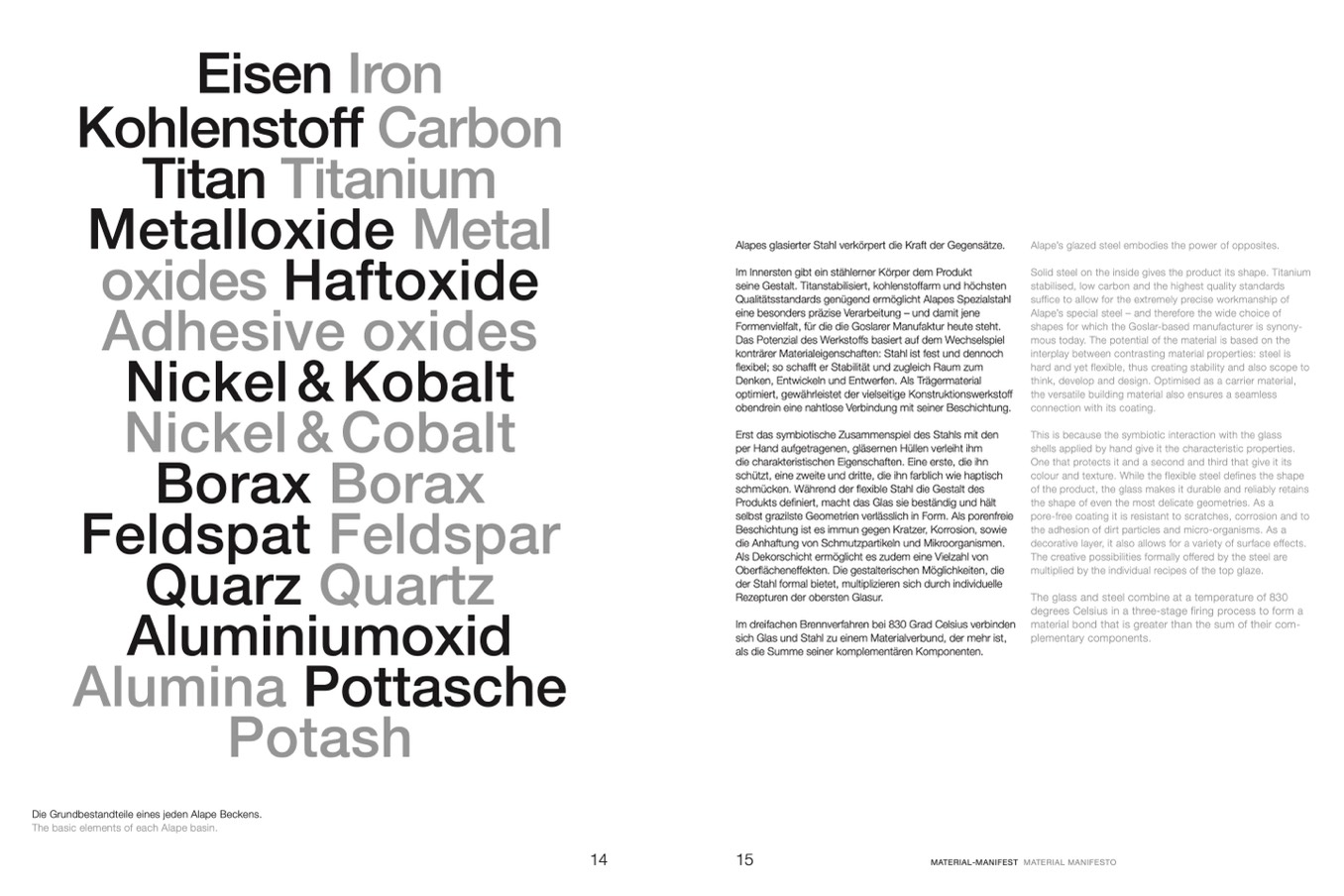
Die Grundbestandteile eines jeden Alape Beckens.
The basic elements of each Alape basin.
Eisen Iron
Kohlenstoff Carbon
Titan Titanium
Metalloxide Metal
oxides Haftoxide
Adhesive oxides
Nickel & Kobalt
Nickel & Cobalt
Borax Borax
Feldspat Feldspar
Quarz Quartz
Aluminiumoxid
Alumina Pottasche
Potash
Alapes glasierter Stahl verkörpert die Kraft der Gegensätze.
Im Innersten gibt ein stählerner Körper dem Produkt
seine Gestalt. Titanstabilisiert, kohlenstoffarm und höchsten
Qualitätsstandards genügend ermöglicht Alapes Spezialstahl
eine besonders präzise Verarbeitung – und damit jene
Formenvielfalt, für die die Goslarer Manufaktur heute steht.
Das Potenzial des Werkstoffs basiert auf dem Wechselspiel
konträrer Materialeigenschaften: Stahl ist fest und dennoch
flexibel; so schafft er Stabilität und zugleich Raum zum
Denken, Entwickeln und Entwerfen. Als Trägermaterial
optimiert, gewährleistet der vielseitige Konstruktionswerkstoff
obendrein eine nahtlose Verbindung mit seiner Beschichtung.
Erst das symbiotische Zusammenspiel des Stahls mit den
per Hand aufgetragenen, gläsernen Hüllen verleiht ihm
die charakteristischen Eigenschaften. Eine erste, die ihn
schützt, eine zweite und dritte, die ihn farblich wie haptisch
schmücken. Während der flexible Stahl die Gestalt des
Produkts definiert, macht das Glas sie beständig und hält
selbst grazilste Geometrien verlässlich in Form. Als porenfreie
Beschichtung ist es immun gegen Kratzer, Korrosion, sowie
die Anhaftung von Schmutzpartikeln und Mikroorganismen.
Als Dekorschicht ermöglicht es zudem eine Vielzahl von
Oberflächeneffekten. Die gestalterischen Möglichkeiten, die
der Stahl formal bietet, multiplizieren sich durch individuelle
Rezepturen der obersten Glasur.
Im dreifachen Brennverfahren bei 830 Grad Celsius verbinden
sich Glas und Stahl zu einem Materialverbund, der mehr ist,
als die Summe seiner komplementären Komponenten.
Alape’s glazed steel embodies the power of opposites.
Solid steel on the inside gives the product its shape. Titanium
stabilised, low carbon and the highest quality standards
suffice to allow for the extremely precise workmanship of
Alape’s special steel – and therefore the wide choice of
shapes for which the Goslarbased manufacturer is synony
mous today. The potential of the material is based on the
interplay between contrasting material properties: steel is
hard and yet flexible, thus creating stability and also scope to
think, develop and design. Optimised as a carrier material,
the versatile building material also ensures a seamless
connection with its coating.
This is because the symbiotic interaction with the glass
shells applied by hand give it the characteristic properties.
One that protects it and a second and third that give it its
colour and texture. While the flexible steel defines the shape
of the product, the glass makes it durable and reliably retains
the shape of even the most delicate geometries. As a
porefree coating it is resistant to scratches, corrosion and to
the adhesion of dirt particles and microorganisms. As a
decorative layer, it also allows for a variety of surface effects.
The creative possibilities formally offered by the steel are
multiplied by the individual recipes of the top glaze.
The glass and steel combine at a temperature of 830
degrees Celsius in a threestage firing process to form a
material bond that is greater than the sum of their com
plementary components.
14
15
MATERIAL-MANIFEST MATERIAL MANIFESTO

